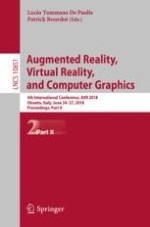2018 | Buch
Augmented Reality, Virtual Reality, and Computer Graphics
5th International Conference, AVR 2018, Otranto, Italy, June 24–27, 2018, Proceedings, Part II
herausgegeben von: Lucio Tommaso De Paolis, Patrick Bourdot
Verlag: Springer International Publishing
Buchreihe : Lecture Notes in Computer Science
